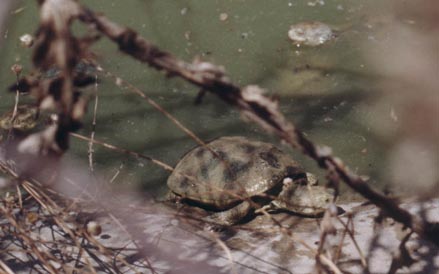Emys orbicularis 
| Želva bahenní je jedinou přirozeně divoce žijící želvou na našem území. Oblast jejího rozšíření ukazuje mapka nahoře. Lze ji nalézt ve většině zemí Evropy kromě Skandinávie, v severní Africe a Blízkém Východě. Tato želva je silně chráněna na většině tohoto území, Českou Republiku nevyjímaje. Mezi chovateli se vyskytuje poměrně často. | The European pond turtle is the only turtle living
in our country in the wild state. Its habitat shows the map above. It is found in most
countries of Europe except Scandinavia, in north Africa and the Near East.
This turtle is strongly protected in the most of the area, as well as in the
Czech Republic. It is relatively common in captivity here.
 Emys orbicularis, Turecko, léto 2000, foto (c) David Krumphanzl Emys orbicularis, Turkey, summer 2000, photo (c) David Krumphanzl Želva bahenní bývá řazena mezi želvy přechodného typu, tj.
vlastně želvy bahenní (končetinami jsou podobné suchozemským želvám, tvarem krunýře zase
vodním). Lze je zahlédnout v prohřátých bahnitých mělkých vodách. Přezimují v bahně na dně. Období jejich
aktivity spadá mezi duben a říjen, páří se v květnu a vejce kladou o měsíc později. Vejce
(obvykle 3 až 16 kusů) kladou často poměrně daleko od vody. Mláďata se líhnou zhruba po 100 dnech,
za chladného léta zůstávají v zemi a vylézají až na jaře. Dospělosti dosahují ve věku mezi
8 a 10 lety, dorůstají délky okolo 25 cm. Mohou se dožít až 120 let.
| The European pond turtle is sometimes indicated to belong among
so-called passing type turtles (who have tortoises-like limbs but the shell is similar rather to
aquatic turtles). It can be spotted in the warm muddy shallow waters with places to bask. They
hibernate hidden in the mud on bottom. Their
activity period lasts from April to October, mating in May and nesting a month later. The eggs
(3 to 16) are sometimes laid relatively far from water. Young turtles hatch after 100 days.
If the summer is colder, they may emerge even in the next spring. Adulthood comes when they are between
8 or 10, the age can reach up to 120 years and lenght around 10 inches.
| Jídelníček této želvy se skládá z ryb, obojživelníků, žížal,
mlžů a hmyzu. V zajetí přijímá živočišnou potravu občas kombinovanou vodními rostlinami nebo
salátem. Potřebuje větší díl souše a místo na vyhřívání; zazimování není nezbytné.
| The turtle diet consist on fish, amphibians, earth-worms,
molluscs, insects, in captivity on feeder fish, crickets etc. sometimes combined with water herbs or lattuce.
It needs a larger land area and basking place when kept. Hibernating is not necessary.
| Koncem léta 1999 jsem se vydal do Bulharska,
krátkou zprávu o želví populaci jsem rozpracoval (ach, jak pomalu to
pokračuje ...) na této adrese. Plánuji také stránku o Turecké populaci
želv z léta 2000.
| At the end of summer 1999 I have visited Bulgaria, a short report
about the tortoise population is here (I am sorry for a very poor progress ...).
I plan to add a report about the tortoises in Turkey, summer 2000.
| | ||
last (partial) update: 25th Sep 2001